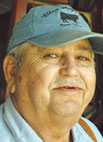
In 50 years as an Angus breeder, Kenneth Elbert has found that the middle of the road isn’t all that bad a place to be.
Because even in farming, trends come and go, but only the good ones come and stay.
The Trends
“There’s always somebody who comes along and says you need to be doing this or that,” Kenneth said.
For instance, back in the 1950s, someone decided Angus should be bred to produce smaller cuts of meat for table consumption.
“The animals were bred down for that,” Kenneth said. “They were very small, fat and short-legged.”
Kenneth, however, chose to keep building his herd with traditionally larger animals.
“By the 1970s, we were right back in the boat,” he said.
A few years later, producers did another about face – striving to breed ever-larger animals.
“At one point, they got too big,” Kenenth recalled, but he follwed the path that was working for him.
“You do not need 1,600-pound cows and 2,000-pound bulls,” he said.
On the other hand, when an idea is good it will resurface, even after being neglected for years.
“In the early ‘50s, they were promoting rotational grazing,” Kenneth said. “About 15 years ago, they decided that’s what needed to be done again.”
Kenneth agrees. His cattle now graze 10- to 20-acre paddocks, each equipped with an automatic water and electric fencing. As the cattle graze one paddock, the other paddocks are growing and are ready for harvest when the paddock in use is grazed down. The rotation allows optimum, but not overgrazing of each paddock.
“It all gets back to efficiency,” Kenneth said. “You need to be able to use what you produce.”
An Angus Decision
Kenneth chose to raise purebred Angus long before he established his own farm.
“I was at my uncle’s one day, playing with my cousins,” he remembered. “He had a commercial herd of Angus. They were lined up at the feed trough, and I thought, ‘Man, that looks awful good.’ And I decided that’s what I wanted to raise.”
He bought his first Angus in the fall of 1959 for use as an FFA project, and he has never considered changing to another breed. He still owns the original 16 acres his dad bought in 1946, along with his own original farm and land he and his dad added to their holdings near Pierce City, Mo., through the years. The farm is now 700 acres.
Along with the staple pasture of southwest Missouri – fescue (mixed with white clover) – Kenneth also has about 30 percent warm-season pasture grasses. He puts up his own hay, including the product of a 40-acre patch of virgin prairie. “Grass is important here,” he said.
The farm produces all its own female replacements, which are bred by AI (a good idea that came around in the 1950s and hasn’t gone away). Calving is scheduled for spring and fall. Along with heifers he doesn’t need, Kenneth retains the best bull calves – about 20 percent – for development and sale by private treaty.
While he doesn’t leap at every new idea that comes along, Kenneth said he does pay a lot of attention to genetics – not to produce the trendiest animal of the moment, but to produce the highest quality with the most efficiency.
“Efficiency is probably the most important thing to breed for, and I want an animal that will grade choice and provide a good product for the table,” he said.
Toward that end, he will continue to be cautious about following the latest farming fads.
“I always research something thoroughly before I jump into it,” he said.
And he will pay special attention to the ways of the past and his own experience.
“All the good advice ends up being true forever,” Kenneth said. “It always comes back to the fundamentals.”
And more than anything, measure by your own yardstick, he advised.
“You need to find what actually works for you and keep doing it,” he said.







